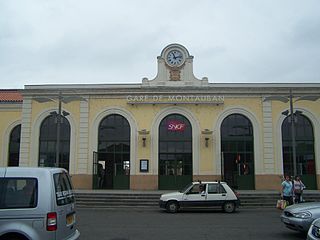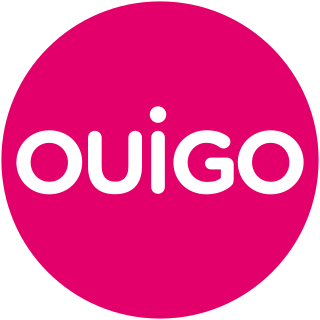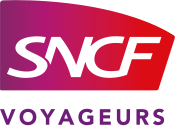
The Société nationale des chemins de fer français is France's national state-owned railway company. Founded in 1938, it operates the country's national rail traffic along with that of Monaco, including the TGV, on France's high-speed rail network. Its functions include operation of railway services for passengers and freight, as well as maintenance and signalling of rail infrastructure. The railway network consists of about 35,000 km (22,000 mi) of route, of which 2,600 km (1,600 mi) are high-speed lines and 14,500 km (9,000 mi) electrified. About 14,000 trains are operated daily.

Gare Montparnasse, officially Paris Montparnasse, is one of the seven large Paris railway termini, and is located in the 14th and 15th arrondissements.

Gare d'Austerlitz, officially Paris Austerlitz, is one of the seven large Paris railway terminal stations. The station is located on the left bank of the Seine in the southeastern part of the city, in the 13th arrondissement. It is the start of the Paris–Bordeaux railway; the line to Toulouse is connected to this line. In 1997, the Ministry of Culture designated the Gare d'Austerlitz a historical monument; it became the fifth large railway station in Paris to receive such a label, as currently only Montparnasse has not been attributed it.

The Gare de l'Est, officially Paris Est, is one of the seven large mainline railway station termini in Paris, France. It is located in the 10th arrondissement, not far southeast from the Gare du Nord, facing the Boulevard de Strasbourg, part of the north–south axis of Paris created by Georges-Eugène Haussmann.

La Défense station is a station of the Transilien suburban rail lines, RER commuter rail network, Paris Métro, as well as a stop of the Île-de-France tram network. In the future, Paris Metro Line 15 of Grand Paris Express will pass through here, making it a huge railway hub. It is underneath the Grande Arche building in La Défense, the business district just west of Paris. The station is the western terminus of Métro Line 1 and connects the RER A line to the Métro Line 1 station since 1992, the Line 2 tramway since 1994 and SNCF (Transilien) train station. It is also attached to a major shopping centre. There are over 25 million entries and exits each year. A temporary special SNCF service began in April 1959 to serve the newly-built Centre of New Industries and Technologies (CNIT); the RER entered service on 19 January 1970.

Transport express régional is the brand name used by the SNCF, the French national railway company, to denote rail service run by the regional councils of France, specifically their organised transport authorities. The network serves French regions; Île-de-France (Transilien) and Corsica (CFC) have their own specific transport systems. Every day, over 800,000 passengers are carried on 5,700 TER-branded trains.
Île-de-France Mobilités is the governmental authority (EPA) that controls and coordinates the different companies operating the Paris-area public transport network and the rest of the Île-de-France region. In this capacity, it issues operating contracts for the various services, owns the buses and rolling stock used on those services, and acts as the main financing body for transport projects in the region. It coordinates the operation of RATP Group, SNCF, and the nearly 90 Optile-affiliated bus companies.

Marne-la-Vallée – Chessy also appearing on platform displays as Marne-la-Vallée Chessy – Parcs Disneyland, is a large combined RER, and high-speed rail station in Chessy, Seine-et-Marne, France, about 30 km (19 mi) east of Paris, located on the LGV Interconnexion Est opened in 1994. The station is inside the Disneyland Paris resort, close to the entrances to the theme parks and at the entrance to Disney Village. The station opened as an extension of RER A in April 1992, in conjunction with the opening of the theme park, with The Walt Disney Company contributing €38.1 million of the €126.5 million cost. The high-speed rail part of the station opened in May 1994, two years after the RER portion of station.
Transilien is the brand name given to the commuter rail network serving Île-de-France, the region surrounding and including the city of Paris. The network consists of nine lines: H, J, K, L, N, P, R, U, and V each operated by SNCF, the state-owned French railway company. The lines begin and end in major Parisian stations, except for lines U and V which connect major stations outside the Paris city borders. Unlike the RER network, the Transilien trains do not cross through the Paris city centre.

Rail transport in France is marked by a clear predominance of passenger traffic, driven in particular by high-speed rail. The SNCF, the national state-owned railway company, operates most of the passenger and freight services on the national network managed by its subsidiary SNCF Réseau. France currently operates the second-largest European railway network, with a total of 29,901 kilometres of railway.

The SNCF Class Z 20500 is a double-deck, dual-voltage electric multiple unit trainset that are operated by SNCF on the Réseau Express Régional (RER), a hybrid suburban commuter and rapid transit system and the Transilien, a suburban commuter rail system, both serving Paris and its Île-de-France suburbs.

Versailles Chantiers station is the principal railway station serving the city of Versailles, a wealthy suburb located west of Paris, France. The station is located at the junction of the Paris–Brest railway and the Grande Ceinture line. The "Chantiers" in the station name comes from its location on the Rue des Chantiers.

Aéroport Charles de Gaulle 1 is one of two railway stations at Charles de Gaulle Airport, the primary airport for the Paris region and the largest in France. The station is served by RER B and CDGVAL.

Juvisy is a railway station in Juvisy-sur-Orge, Essonne, Île-de-France, France. The station was opened in 1840 and is on the Paris–Bordeaux railway, Villeneuve-Saint-Georges-Montargis railway and Grande Ceinture line, a freight railway around Paris. The station is served by Paris' express suburban rail system, the RER Line C and RER Line D. The train services are operated by SNCF. A TGV high-speed service also serves the station. During a survey in 2015, the station served 33,426,629 passengers in that year.

Melun station is a railway station in Melun, Seine-et-Marne, Paris, France. The station was opened on 3 January 1849 and is on the Paris–Marseille railway. The station is served by Paris' express suburban rail system, the RER. The train services are operated by SNCF.

Montauban or Montauban-Ville-Bourbon is a railway station serving the town of Montauban, Tarn-et-Garonne department, southwestern France.

Ouigo is a French low-cost service range of both conventional and high-speed trains. The literal translation of Ouigo from French to English is "yes go"; the name is also a play on words with the English homonym "we go." It is composed of two different services: Ouigo Grande Vitesse, which is a brand of SNCF operating high-speed trains; and Ouigo Vitesse Classique, a brand under which Oslo, a subsidiary of SNCF, operates conventional speed trains.

Île-de-France tramway Line 13 Express is a suburban tram-train line in Yvelines, west of Paris, which opened on 6 July 2022. The line is operated by Transkeo T12-T13, a joint venture 51% owned by Keolis and 49% by SNCF Voyageurs.

TGV inOui is the brand name of premium TGV train services operated by SNCF since 27 May 2017 on certain high speed rail services. SNCF is in the process of replacing 'classic' TGV services with the premium inOui and low-cost Ouigo brands in preparation for the future opening of France's high-speed rail infrastructure to competition. The name 'inOui' was adopted because it resembles the French word inouï meaning “extraordinary”.

















